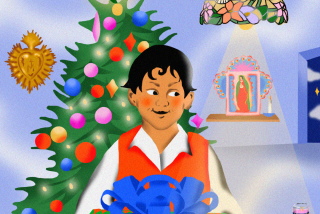Russian Santa Suffers Identity Crisis
- Share via
MOSCOW — You might think Santa Claus has a tough job, what with flying all over the world in a single night and figuring out who’s been naughty or nice. But these days, he has it easy compared with his Russian cousin, Ded Moroz.
Russia’s big winter holiday is New Year’s, and today is when Ded Moroz makes his rounds. By tradition, he has a somewhat more arduous job than Santa: He usually delivers gifts in person, and he has no brigade of elves to help, just a young girl called Snow Maiden.
This year, Ded Moroz faces extra troubles. For one thing, the country’s economic crisis is casting a pall over moods and holiday buying.
Ambitious politicians and regional developers are hijacking his celebrity to promote their own causes. And perhaps most critically, he is suffering an acute identity crisis that is partially Santa Claus’ fault.
Ded Moroz, whose name means Grandfather Frost, has a snowy white beard and jolly red nose a lot like Santa’s. But Russians say there are important differences.
For instance, Santa Claus is fat, while Ded Moroz is sometimes thin. Santa wears a short red jacket and trousers, while Ded Moroz wears a long flowing robe that can be a number of colors, including blue and white. Ded Moroz carries a staff in addition to his sack of toys, and, while he sometimes rides a sleigh, it is pulled by horses, not reindeer.
Now, though, largely because of an invasion of imports, the bearded figure bedecking Russian storefronts and lampposts looks more and more like the trousered, imported Santa and less like Russia’s beloved winter icon. At central Moscow shopping centers, images of Santa outnumber Ded Moroz by a hefty margin.
“Technically, these are all Santa Claus,” said Roza Zhuraviyeva, a salesclerk in the posh GUM department store who gestured to her display of trinkets bearing the image of the chubby, Western-style figure. “Of course, I’d rather sell our own national version. But this is all made in China, and they only know Santa Claus.”
Some politicians, notably Moscow Mayor Yuri M. Luzhkov, have begun to promote Ded Moroz as a true symbol of the Russian spirit--in contrast to the non-Russian Santa, whom they consider crass and commercialized.
“Take a look at our huge, handsome Ded Moroz,” Luzhkov bellowed earlier this week after escorting Ded Moroz through central Moscow in a sleigh. “The puny Santa Claus is a far cry from him!”
Luzhkov even went so far as to claim that Ded Moroz doesn’t live at the North Pole or in Finnish Lapland, as has long been assumed. Instead, he declared, Ded Moroz grew up right here in Russia, in a poor but pristine town about 450 miles northeast of Moscow named Veliky Ustyug.
Luzhkov’s idea, it seems, is to turn Veliky Ustyug into a tourist attraction that would bring trainloads of children from the capital and presumably generate profits as well as national feeling.
“It’s a splendid northern Russian city,” proclaimed Ded Moroz himself during a news conference called by the mayor. “Ded Moroz could have been born there. Why not?”
One reason the Ded Moroz myth is up for grabs is that it is far less developed than the Santa Claus legend, says Sergei A. Arutyunov, an expert on Russian anthropology. Despite Luzhkov’s bluster, Arutyunov says, Ded Moroz is basically a pastiche based on the Western story of St. Nicholas.
“Whatever differences exist between Santa Claus and Ded Moroz, they can’t camouflage the main thing--there is nothing inherently Russian about Ded Moroz,” he says.
Arutyunov explains that Ded Moroz began to appear in Russia in the late 19th century as one of a number of holiday trappings borrowed from the West. Then he was banned for a significant portion of the Soviet period as a “reactionary religious remnant.”
“Ded Moroz does not have a long historical and cultural tradition in Russia, and even the tradition that exists has been interrupted once or twice,” he says.
Undaunted by such humbug, many Russians persist in believing Ded Moroz superior to Santa, and they insist on their preference at Lyudmila Rotan’s costume stand inside GUM.
“People usually ask specifically for Ded Moroz,” Rotan said, pulling out a red-robed felt costume selling for about $30. “But at various times, we have celebrated Christmas and New Year’s different ways. Personally, I don’t think it’s that important.”
More to Read
Sign up for The Wild
We’ll help you find the best places to hike, bike and run, as well as the perfect silent spots for meditation and yoga.
You may occasionally receive promotional content from the Los Angeles Times.






